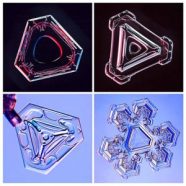Scientists explain mystery of triangular snowflakes
A snowflake's fall helps determine its shape

Most people who love snow have to wait for winter. But that’s not the case for Kenneth Libbrecht, a scientist in sunny southern California. In his laboratory, he’s got snow all year long.
But the light white stuff is not falling from the sky—it’s growing in a lab. Libbrecht studies the science of snowflakes at the California Institute of Technology in Pasadena. He is a physicist, or a scientist who studies motion, matter and energy. In a recent experiment, Libbrecht and another physicist, Hannah Arnold, solved an old mystery about the shape of snowflakes.
They were able to figure out one way in which triangle-shaped snowflakes form in nature. Snowflakes are hexagonal, which means they have six sides, but snowflake-watchers have been seeing three-sided snowflakes—or at least, snowflakes with three long sides and three short sides—for a long time. “People have noticed them for hundreds of years,” says Libbrecht. Until now, scientists didn’t know how they formed.
In the laboratory, Libbrecht and Arnold created an artificial snowfall and looked at the flakes to study their shapes. Most of them, as they had expected, had six sides of roughly equal length. But once they counted up all the triangle-shaped snowflakes, they found more than they had been expecting—suggesting that three-sided snowflakes may not be rare at all.
They reasoned that as a snowflake falls, it may come across a tiny piece of dust in the air. These bits of dust can cause one edge of the snowflake to tilt up. As a result, the two sides that are pointing down may grow faster as the wind blows by and adds more fluff to the growing flake. Libbrecht and Arnold found that snowflakes that form in this way are stable, which means they don’t change very much before they land on the ground.
Snowflakes may seem like a beautiful topic for a scientific investigation—but there’s more to them than the geometry of three- and six-sided figures. This experiment by Libbrecht and Arnold helps scientists learn about aerodynamics, or the study of how objects move through the air. Without knowing about aerodynamics, it would be impossible to build airplanes or send rockets into space.
But, of course, they are beautiful—and no one knows it better than Libbrecht, who keeps the snow growing year-round. In addition to studying the snow, he takes pictures of snowflakes and publishes them in books and online.
POWER WORDS
aerodynamics The study of bodies moving relative to gases, especially the interaction of moving objects with the atmosphere.
hexagon A polygon with six sides.
triangle A polygon with three sides.
physics The science of matter and energy and of interactions between the two, grouped in traditional fields such as acoustics, optics, mechanics, thermodynamics, and electromagnetism, as well as in modern extensions including atomic and nuclear physics, cryogenics, solid-state physics, particle physics, and plasma physics.







